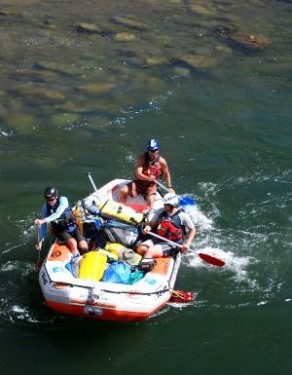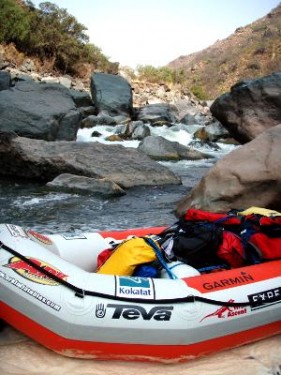
Humans have always been drawn to rivers writes Mark Kalch.
Journeying by river, in my mind, is the pre-eminent way to explore our amazing planet. It allows us a glimpse into regions impossible to access practicably by any other means.
Because rivers begin their journey high among the mountains and flow through continents all the way to the sea, they cross every environment on the planet: through mountains, jungles, deserts, grasslands, snow and ice and even cities. It follows that a river expedition can become one of the most diverse and interesting undertakings possible.
Choosing a river
Whether you plan on paddling a Class II river in the UK, a steep alpine creek in the US or the Congo River in Africa, there are certain considerations to make in order to maximise safety, success and experience.
Choosing what river to run is logically your first decision to make. Technical expertise, time available, purpose, solo or team are all factors to consider in this choice. With little or no paddling experience, choosing to make a source to sea descent of a 4000 mile plus river might not be wise. Instead, why not try a 200 mile river? By no means a cake walk and a way to develop essential skills that are common with a much larger undertaking.

Solo or team?
Will you paddle alone or as part of a team? Both offer distinct advantages and disadvantages. Solo expeditions give you the benefit of only having to take care of Number 1. Decisions, right are wrong fall squarely on your shoulders. Logistically, a solo paddling journey is also much more straight forward. On the other hand, when the kak hits the fan, you are on your own. Sure, maybe you take with you a SPOT device or similar but as you are pulled into a siphon from hell, you might as well be on the far side of the moon.
A team expedition can allow much greater flexibility. Your ability to push the envelope is much enhanced by having safety in place. Progress can be massively increased (not that you should wish it all over too soon!), decisions on what to run and how, where to camp, how to proceed in the face of local bureaucracy can be made shared responsibilities.
Type of boat
What craft best suits the river you intend to paddle? Inflatable raft, canoe, kayak, pack raft, SUP board, pirogue? Your choice will depend on personal preference, solo or team, support or none and type of river. A locally constructed wooden canoe might be a fun way to explore but it’s ability to handle significant whitewater is certainly limited. A modern whitewater raft will take on the biggest rapids and haul all your gear, but crawl like a snail on flat water. You may have to compromise if choosing a single craft to run an entire river with ever changing hydraulics. If you choose to utilise multiple craft on your descent be aware of the added demands logistically.
Beyond your boat, proper outfitting of the expedition is essential. Using a river to access isolated places is fine, but do keep in mind that rivers, for the most part only travel one way. Loss or damage to priority kit without adequate spares, quite often means that replacement is only possible when you once more emerge to a more accessible area. Using quality drybags, safety and paddling gear, camping and cooking equipment, lessens, but does not entirely rule out this eventuality.

Maps
Adequate mapping of the region through which your river will take you is more often than not essential. Topographic maps, while unable to display individual river features, give you an excellent indicator of what might be there. A sharp decrease in elevation over a short distance is a tell tale sign that you are about to have a whole lot of fun and you had best be prepared.
Good maps also display settlements, villages, towns and cities that lie on the banks of a river or within close proximity. Re-supply and if necessary evacuation can be made much easier with this knowledge.
The details
While the practice of planning and executing a big river expedition is massive and well beyond the scope of this article, don’t get caught up in the details.
I am a firm believer in proper planning and preparation helping in a huge way to ensure a successful expedition. However, you can plan the life out of a river journey, any journey. Endless checkpoints, dates to be at a certain marker, knowing exactly what is around the next bend takes all the fun out of it. Letting the gentle, meandering flow of a river propel you along into the unknown is what makes a paddling expedition so amazing.
Let yourself go, get on a river.
Mark Kalch has made a source to sea paddling descent of the entire Amazon River and in 2012 continues his 22,000 mile ‘7 rivers, 7 continents’ project. Learn more at www.markkalch.com or follow him on Twitter @MarkKalch
This article was written as part of the Adventurer’s Blogging Chain. The previous piece, We Are Incredible, was written by Dan Martin. The next article will appear on Sarah Outen’s website.
What do you think? Please do add your thoughts below…